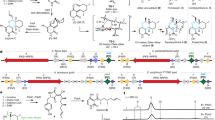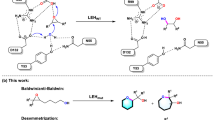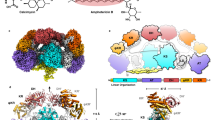Abstract
The reaction of enol(ate)s with electrophiles is used extensively in organic synthesis for stereoselective C–C bond formation. Protein-based catalysts have had comparatively limited application for the stereoselective formation of C–C bonds of choice via enolate chemistry. We describe protein engineering studies on 5-carboxymethylproline synthases, members of the crotonase superfamily, aimed at enabling stereoselective C–C bond formation leading to N-heterocycles via control of trisubstituted enolate intermediates. Active site substitutions, including at the oxyanion binding site, enable the production of substituted N-heterocycles in high diastereomeric excesses via stereocontrolled enolate formation and reaction. The results reveal the potential of the ubiquitous crotonase superfamily as adaptable catalysts for the control of enolate chemistry.
This is a preview of subscription content, access via your institution
Access options
Subscribe to this journal
Receive 12 print issues and online access
$259.00 per year
only $21.58 per issue
Buy this article
- Purchase on Springer Link
- Instant access to full article PDF
Prices may be subject to local taxes which are calculated during checkout





Similar content being viewed by others
References
Schultz, P. & Lerner, R. From molecular diversity to catalysis: lessons from the immune system. Science 269, 1835–1842 (1995).
Reymond, J. Stereoselectivity of aldolase catalytic antibodies. J. Mol. Catal. B 5, 331–337 (1998).
Dean, S., Greenberg, W. & Wong, C. Recent advances in aldolase-catalyzed asymmetric synthesis. Adv. Synth. Catal. 349, 1308–1320 (2007).
Bolt, A., Berry, A. & Nelson, A. Directed evolution of aldolases for exploitation in synthetic organic chemistry. Arch. Biochem. Biophys. 474, 318–330 (2008).
Hamed, R. B., Batchelar, E. T., Clifton, I. J. & Schofield, C. J. Mechanisms and structures of crotonase superfamily enzymes—how nature controls enolate and oxyanion reactivity. Cell. Mol. Life Sci. 65, 2507–2527 (2008).
Grogan, G., Roberts, G. A., Bougioukou, D., Turner, N. J. & Flitsch, S. L. The desymmetrization of bicyclic β-diketones by an enzymatic retro-Claisen reaction. A new reaction of the crotonase superfamily. J. Biol. Chem. 276, 12565–12572 (2001).
Hamed, R. B., Mecinovic, J., Ducho, C., Claridge, T. D. W. & Schofield, C. J. Carboxymethylproline synthase catalysed syntheses of functionalised N-heterocycles. Chem. Commun. 46, 1413–1415 (2010).
Yu, W. et al. Mutation of Lys242 allows Δ3,Δ2-enoyl-CoA isomerase to acquire enoyl-CoA hydratase activity. Biochim. Biophys. Acta 1760, 1874–1883 (2006).
Xiang, H., Luo, L., Taylor, K. L. & Dunaway-Mariano, D. Interchange of catalytic activity within the 2-enoyl-coenzyme A hydratase/isomerase superfamily based on a common active site template. Biochemistry 38, 7638–7652 (1999).
Hamed, R. B., Batchelar, E. T., Mecinović, J., Claridge, T. D. W. & Schofield, C. J. Evidence that thienamycin biosynthesis proceeds via C-5 epimerization: ThnE catalyzes the formation of (2S,5S)-trans-carboxymethylproline. ChemBioChem 10, 246–250 (2009).
Batchelar, E. T. et al. Thioester hydrolysis and C–C bond formation by carboxymethylproline synthase from the crotonase superfamily. Angew. Chem. Int. Ed. 47, 9322–9325 (2008).
Sleeman, M. C., Sorensen, J. L., Batchelar, E. T., McDonough, M. A. & Schofield, C. J. Structural and mechanistic studies on carboxymethylproline synthase (CarB), a unique member of the crotonase superfamily catalyzing the first step in carbapenem biosynthesis. J. Biol. Chem. 280, 34956–34965 (2005).
Sleeman, M. C. & Schofield, C. J. Carboxymethylproline synthase (CarB), an unusual carbon–carbon bond-forming enzyme of the crotonase superfamily involved in carbapenem biosynthesis. J. Biol. Chem. 279, 6730–6736 (2004).
Gerratana, B., Arnett, S. O., Stapon, A. & Townsend, C. A. Carboxymethylproline synthase from Pectobacterium carotorova: a multifaceted member of the Crotonase superfamily. Biochemistry 43, 15936–15945 (2004).
Erb, T. J. et al. Synthesis of C5-dicarboxylic acids from C2-units involving crotonyl-CoA carboxylase/reductase: The ethylmalonyl-CoA pathway. Proc. Natl Acad. Sci. USA 104, 10631–10636 (2007).
Erb, T. J., Brecht, V., Fuchs, G., Muller, M. & Alber, B. E. Carboxylation mechanism and stereochemistry of crotonyl-CoA carboxylase/reductase, a carboxylating enoyl-thioester reductase. Proc. Natl Acad. Sci. USA 106, 8871–8876 (2009).
Johannes, T. W. & Zhao, H. Directed evolution of enzymes and biosynthetic pathways. Curr. Opin. Microbiol. 9, 261–267 (2006).
Williams, G. J., Nelson, A. S. & Berry, A. Directed evolution of enzymes for biocatalysis and the life sciences. Cell. Mol. Life Sci. 61, 3034–3046 (2004).
Reetz, M. T. Laboratory evolution of stereoselective enzymes: a prolific source of catalysts for asymmetric reactions. Angew. Chem. Int. Ed. 50, 138–174 (2011).
Holden, H. M., Benning, M. M., Haller, T. & Gerlt, J. A. The crotonase superfamily: divergently related enzymes that catalyze different reactions involving acyl coenzyme A thioesters. Acc. Chem. Res. 34, 145–157 (2001).
Widboom, P. F., Fielding, E. N., Liu, Y. & Bruner, S. D. Structural basis for cofactor-independent dioxygenation in vancomycin biosynthesis. Nature 447, 342–345 (2007).
Thompson, J. D., Higgins, D. G. & Gibson, T. J. CLUSTALW: improving the sensitivity of progressive multiple sequence alignment through sequence weighting, position-specific gap penalties and weight matrix choice. Nucleic Acids Res. 22, 4673–4680 (1994).
Acknowledgements
The authors acknowledge the Biotechnology and Biological Sciences Research Council, the Ministry of Higher Education (Egypt, R.B.H.), CONACyT and FIDERH (Mexico, R.G.C.), Cancer Research UK (A.T.) and the Deutsche Akademie der Naturforscher Leopoldina (Germany, C.D.) for financial support. The ccr/pET3d construct was a kind gift from B.E. Alber at the Ohio State University.
Author information
Authors and Affiliations
Contributions
R.B.H. and D.H. identified and prepared CMPSs. R.G.C. prepared Ccr. R.B.H., D.H. and R.G.C. carried out enzyme assays and analysed the results. R.B.H. purified and ran NMR analysis of the products of enzyme catalysis. R.B.H. and T.D.W.C. analysed the NMR data. A.T. synthesized the (2S,5S,6R)-6-ethylcarbapenam methyl ester. C.D. synthesized protected L-AASA (2). R.B.H. and C.J.S. designed the study and wrote the manuscript. All authors commented on the manuscript.
Corresponding author
Ethics declarations
Competing interests
The authors declare no competing financial interests.
Supplementary information
Rights and permissions
About this article
Cite this article
Hamed, R., Gomez-Castellanos, J., Thalhammer, A. et al. Stereoselective C–C bond formation catalysed by engineered carboxymethylproline synthases. Nature Chem 3, 365–371 (2011). https://doi.org/10.1038/nchem.1011
Received:
Accepted:
Published:
Issue Date:
DOI: https://doi.org/10.1038/nchem.1011
This article is cited by
-
Thioester-mediated biocatalytic amide bond synthesis with in situ thiol recycling
Nature Catalysis (2022)
-
Biocatalytic production of bicyclic β-lactams with three contiguous chiral centres using engineered crotonases
Communications Chemistry (2019)



